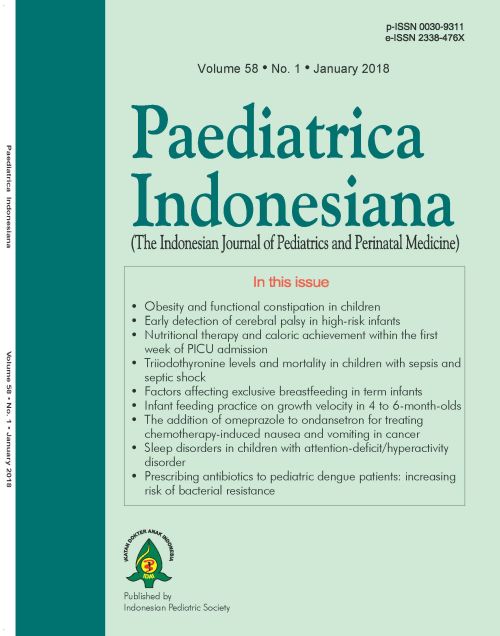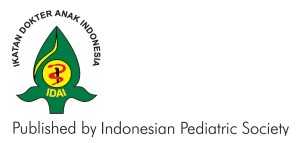Infant feeding practice on growth velocity in 4-6 month-olds
Abstract
Background In developing countries, 5-10% of infants suffer from failure to thrive. Adequate feeding is the most crucial factor for optimal growth in early life.
Objective To assess the differences in growth velocity at 4 to 6 months of age, based on the infant feeding practices.
Methods This cross-sectional study involving 4 to 6 month-old babies from 6 public health centres in Yogyakarta was performed from August to November 2016. Data on body weight, and growth velocity as they related to weight at birth were collected. Subjects were divided into groups according to their feeding practices.
Results Of 173 subjects, 130 (75%) infants were exclusively breastfed, 19 infants (11%) were given breast milk and formula, 14 (8%) infants were given breast milk and complementary food (8%), and 10 (6%) infants were given formula and complementary food. The mean growth velocity z-scores by group were as follows: exclusively breastfed 0.04 (SD 1.15) (95%CI -0.16 to 0.24), breast milk and formula -0.61 (SD 0.84) (95%CI -1.01 to -0.21), breast milk and complementary food -0.69 (SD 1.14) (95%CI -1.35 to -0.04), formula and complementary food 0.23 (SD 1.50) (95%CI: -0.84 to 1.31). The mean difference in growth velocity between the exclusively breastfed vs. breast milk and formula groups was 0.65 (SD 0.28) (95%CI: 0.10 to 1.20; P=0.02); vs. breast milk and complementary food was 0.73 (SD 0.32) (95%CI: 0.10 to 1.37; P=0.02); and vs. formula and complementary food was -0.19 (SD 0.37) (95%CI: -0.93 to 0.55; P=0.61).
Conclusion Exclusively breastfed have the most optimal growth velocity compared to infants who experience other feeding practices.
References
2. Tanuwidjaya S. Kebutuhan dasar tumbuh kembang anak. In: Narendra MB, Sularyo TS, Soetjiningsih, Suyitno H, IG NGR, Wiradisuria S, editors. Buku ajar tumbuh kembang anak dan remaja. 1st. Jakarta: Sagung Seto; 2002. p. 13-21.
3. Kramer MS, Guo T, Platt RW, Shapiro S, Collet J-P, Chalmers B, et al. Breastfeeding and infant growth: Biology or bias? Pediatrics. 2002;110.
4. Johnson L, Jaarsveld V, Llewellyn C, Cole T, Wardle J. Associations between infant feeding and the size, tempo and velocity of infant weight gain: SITAR analysis of Gemini twin birth cohort. Int J Obes. 2014;38:980-987.
5. Heinig MJ, Nommsen LA, Peerson JM, Lonnerdal B, Dewey KG. Energy and protein intakes of breast-fed and formula-fed infants during the first year of life and their association with growth velocity: The DARLING study. Am J Clin Nutr. 1993;58:152-161.
6. Syarif DR, Nasar SS. Failure to thrive. Pedoman pelayanan medis. Jakarta: Ikatan Dokter Anak Indonesia; 2010.
7. Sjarif DR, Yuliarti K, Lestari ED, Sidiartha IGL, Nasar SS, Mexitalia M. Rekomendasi praktik pemberian makan berbasis bukti pada bayi dan balita di Indonesia untuk mencegah malnutrisi. Jakarta: Ikatan Dokter Anak Indonesia; 2015.
8. Suradi R. Spesifisitas biologis air susu ibu. Sari Pediatri. 2001;3:125-129.
9. Carling SJ, Demment MM, Kjolhede CL, Olson CM. Breastfeeding duration and weight gain trajectory in infancy. Pediatrics. 2015;135.
10. Stein MT, Kessler DB, Hubbard E. Failure to thrive in a 4-month-old nursing infant. J Dev Behav Pediatr. 2004;25:S69-73.
11. Yamakawa M, Yorifuji T, Kato T, Inoue S, Tokinobu A, Tsuda T, et al. Long-term effects of breastfeeding on children's hospitalization for respiratory tract infections and diarrhea in early childhood in Japan. Matern Child Health J. 2015;19:1956-65.
12. Pugliese MT, Weyman-Daum M, Moses N, Lifshitz F. Parental health beliefs as a cause of nonorganic failure to thrive. Pediatrics. 1987;80:175-82.
13. Kelleher KJ, Casey PH, Bradley RH, Pope SK, Whitsade L, et al. Risk factors and outcomes for failure to thrive in low birth weight preterm infants. Pediatrics. 1993;91:941-8.
14. Wright C, Loughridge J, Moore G. Failure to thrive in a population context: two contrasting studies of feeding and nutritional status. Proc Nutr Society. 2000;59:37-45.
15. Wright CM, Parkinson KN, Drewett RF. How does maternal and child feeding behavior relate to weight gain and failure to thrive? data from a prospective birth cohort. Pediatrics. 2006;117:1262-9.
16. Patel R, Tilling K, Lawlor DA, Howe LD, Bogdanovich N, Matush L, et al. Socioeconomic differences in childhood length/height trajectories in a middle-income country: a cohort study. BMC Public Health. 2014;14:932
17. Imai CM, Gunnarsdottir I, Thorisdottir B, Halldorsson TI, Thorsdottir I. Associations between infant feeding practice prior to six months and body mass index at six years of age. Nutrients. 2014;6:1608-17.
18. Li R, Fein SB, Grummer-Strawn LM. Association of breastfeeding intensity and bottle-emptying behaviors at early infancy with infants' risk for excess weight at late infancy. Pediatrics. 2008;122:S77-S84.
19. Batubara JR, AAP BT, Pulungan AB. Pertumbuhan dan gangguan pertumbuhan. Buku Ajar Endokrinologi Anak. I: UKK Endokrinologi Anak dan Remaja IDAI; 2010.
Authors who publish with this journal agree to the following terms:
Authors retain copyright and grant the journal right of first publication with the work simultaneously licensed under a Creative Commons Attribution License that allows others to share the work with an acknowledgement of the work's authorship and initial publication in this journal.
Authors are able to enter into separate, additional contractual arrangements for the non-exclusive distribution of the journal's published version of the work (e.g., post it to an institutional repository or publish it in a book), with an acknowledgement of its initial publication in this journal.

This work is licensed under a Creative Commons Attribution-NonCommercial-ShareAlike 4.0 International License.
Accepted 2018-02-15
Published 2018-03-20












